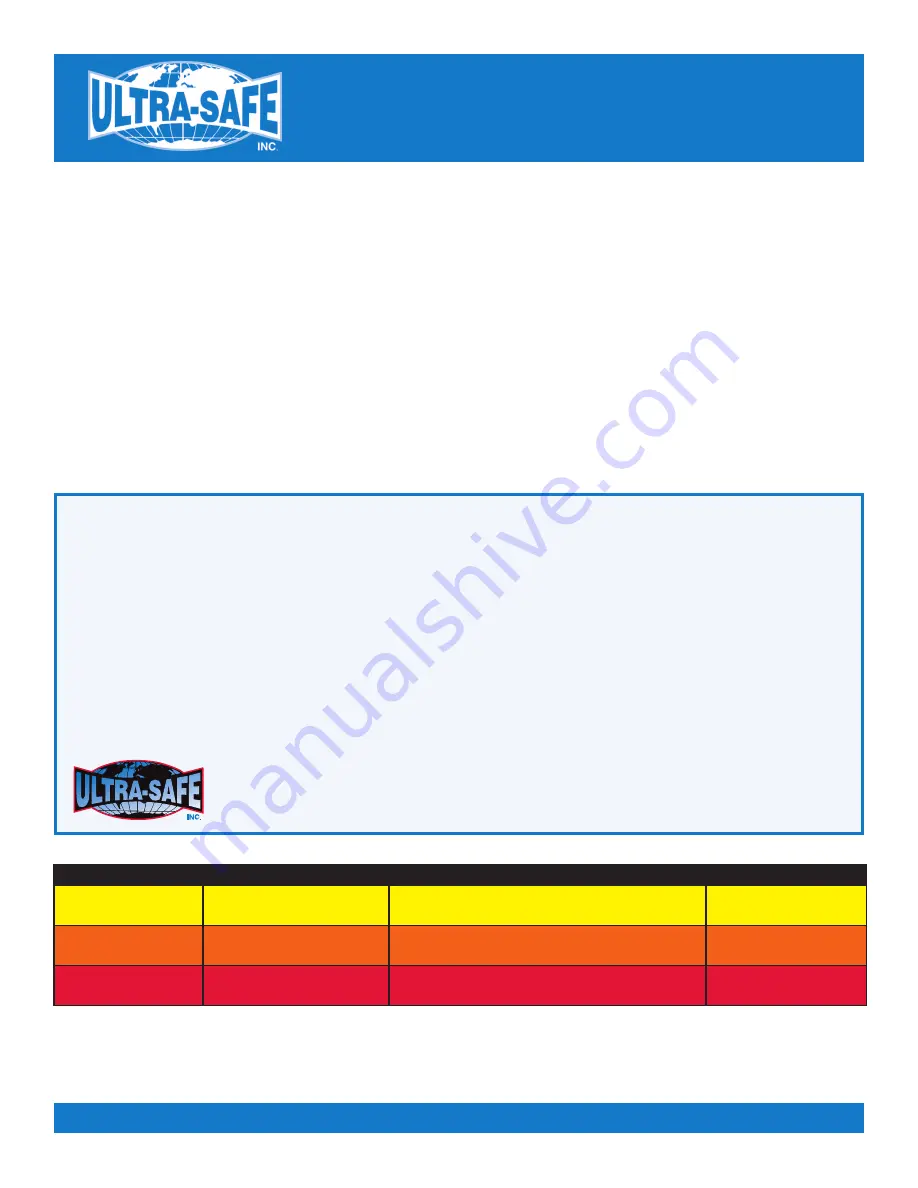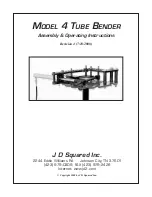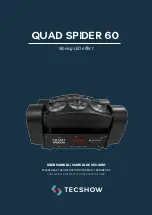
2
BEFORE EACH USE:
Inspect all your personal fall protection
equipment before each use. OSHA 1910.66 and
1926.502 and ANSI Z359.14 Class B (SLE)
requires an inspection before each use. The
use of American National Standards is
completely voluntary. Their existence does not,
in any respect, preclude anyone. ANSI requires
a formal documented inspection of fall
protection equipment to be completed by a
competent person other than the user, at a
minimum of once a year. More frequent
inspections by a competent person may be
required based on the severity of the
workplace conditions.
ULTRA-SAFE equipment is designed for use
with only ULTRA-SAFE approved components
and ULTRA-SAFE sub systems. Substitutions
or replacements made with non-approved
components or subsystems may jeopardize
compatibility of equipment and may affect the
safety and reliability of a complete system.
Personal fall arrest systems must meet
applicable local, state, and federal OSHA
requirements. Connectors (hooks. Carabiners.
and D-Rings) must be capable of supporting at
least 5000 Ibs. Do not use equipment that is not
compatible with the anchorage or other
system components. Connectors must be
compatible in size, shape, and strength. Self
locking snap hooks and carabiners are required
by ANSI Z359.14 Class B (SLE) and OSHA.
NOTE:
Large throat opening snap hooks
should not be connected to standard size D-
Rings or similar objects which will result in a
load on the gate if the hook or D-Ring rotates
or twist. Large throat snap hooks are designed
for use on fixed structural elements such as
cross members or rebar that are not shaped in
a way that can capture the gate of the hook.
FALL:
After a fall, equipment which has been
subjected to fall arrest forces MUST be
removed from service for inspection. Inspect
the entire safety retractable lanyard such as the
load / impact indicator. On web style find the
fold on the web to see if the stitching is broken
and the fold torn apart or for wire style check
the swivel snap hook to see if the RED indicator
was engaged. The safety retractable lanyard
must be removed from service and returned to
an authorized service station for repair, do not
re-stitch or repair..
ULTRA-SAFE
®
SAFETY RETRACTABLE DEVICE INSPECTION CRITERIA: The authorized person using this equipment shall, at a minimum comply with manufacturer’s
instructions regarding the inspection, maintenance, and removal from service of the equipment. Equipment shall be inspected by the authorized person before each use.
Additionally, inspections shall be conducted by a competent person other than the user. Inspection criteria for the equipment shall be set by the safety program administrator.
Documentation of equipment inspection shall be maintained by the safety program administrator. Inspections shall be conducted in intervals based on the type of use,
infrequent, moderate, and severe. If inspections reveal defects, damage, stress, activated warning systems or inadequate maintenance, the equipment shall be permanently
removed from service or undergo corrective maintenance through the manufactures authorized service department
.
Type of Use:
Application Example:
Conditions of Use:
Inspection Frequency:
Infrequent to Light
Rescue and confined space,
factory maintenance
Good storage conditions, indoor or infrequent outdoor
use, room temperature, clean environments
Annually
Moderate to Heavy
Transportation, residential
construction, utilities, warehouse
Fair storage conditions, indoor and extended outdoor
use, all temperatures, clean or dusty environments
Semi-annually to annually
Severe to Continuous
Commercial construction,
oil and gas mining
Harsh storage conditions, prolonged or continuous
outdoor use, all temperatures, dirty environment
Quarterly to semi-annually
Inspection Requirements (normative)
I acknowledge that I have read
and understood the competent
inspection section completely
and agree to abide by them.
COMPETENT INSPECTION:
1. Ensure the safety retractable locks when
the lifeline is pulled sharply, with no
slippage. Lock-up should be positive.
2. Labels must be present and fully legible.
3. Check the connecting hooks or carabiners
for damage, distortion, or corrosion, and
working condition.
4. Check the housing for distortion, cracks, or
other damage and make sure anchorage
point is not distorted or damaged.
5. Inspect each component of the personal
fall protection system according to the
manufacturers instructions.
6. The lifeline must fully extend and retract
smoothly with no hesitation or slack on
the line.
7. Check the lifeline for cuts, burns, chemical
damage, abrasions, loose strands, or
corrosion, the lifeline must not be
damaged.
8. Check for loose or missing screws and
bent or damaged parts.
9. Use of this equipment in areas where
surrounding hazards exist may require
additional precautions to reduce the
possibility of injury to the user or damage
to the equipment. Hazards may include,
but are not limited to: high heat, caustic
chemicals, corrosive environments, high
voltage power lines, explosive or toxic
gases, moving machinery, or overhead
materials that may fall and contact the
user or fall arrest system.
10.
CAUTION -
This unit has an internal
shock absorbing system. Do not attach
external shock absorber to either end of
retractable. Doing so may cause the
brake pull to disengage increasing
freefall.
11. Do not use standard web retractables in
temperatures over 122ª degrees F
12. A competent inspection is required at
least one time per year.
Name (Print) ____________________________ Date _______________
Signature __________________________________________________






























